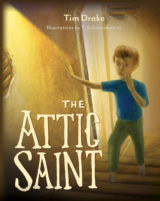By Tim Drake
Tim Drake serves as executive director of Pacem in Terris Hermitage Retreat Center. An award-winning author and former journalist, his books include The Attic Saint, Behind Bella, and the children’s coloring books Viva Cristo Rey! and From an Angel in a Dream. He resides in St. Joseph, Minnesota with his wife and children.

Jesus Christ knew the power of words. He was the Word. When Christ became man and began his public ministry, he most often conveyed truths about Heaven, His Heavenly Father, and living a moral life through stories.
For as long as human beings have existed and been able to communicate, the primary way they’ve shared information, taught, or entertained has been through story—whether verbal or written.
Why do you suppose that is? Does it have to do with our ability to remember stories easily, or the power of a story to move people? Decades after hearing a good story, we can remember it, or at the very least remember the lesson it conveys.
Parents play a pivotal role in story-telling for their children. They are a child’s first story tellers. They model to their children not only through their actions, but also by the stories they tell.
Think of George Washington chopping down the cherry tree, or the tortoise and the hare, or the lion and the mouse.
Stories shape us, guide us, and lead us. My own mother’s story-telling—even making up stories of her own—led to my own love of books, stories, and libraries, a passion I’ve shared with my children, a passion that has shaped my life’s work as a writer, and even shapes my relationship with my wife. When we go out for weekly date nights, Mary does hand-work such as knitting, while I read aloud stories from Rumer Godden, Charles Dickens, Michael O’Brien, Graham Greene, and others.
In the fertile imagination of a child, stories take on a life of their own. We picture the stories we are told. Stories help children make sense of the world, help us to understand others, and help us to know how to interact. The right stories can help us to live moral lives. The wrong stories can lead us on very unhelpful paths.
Christ used stories to explain theological concepts, to shine light on human behavior, to teach and guide. As Catholic Christians, who hear these stories over and over again at Mass, we are often accused by non-Catholics of not being able to cite Scripture and verse. Yet, in hearing these stories, we know them. They are deeply embedded in us; so much so, that if we hear just part of a line, we can often finish the entire story ourselves.
“There once was a man who had two sons . . . ”
“A poor widow had two small coins . . . ”
“A Jewish man was traveling from Jerusalem to Jericho. Along the way, he was attacked by bandits . . . ”
And each of Christ’s parables contains a lesson, not only for its original hearers, but for those of us who share these living stories today. They teach us how to forgive, how to love, and how to be truly charitable.
Children, especially, because of their development—but all of us really—learn best through stories. And it is vital that we have stories that are true, stories that are good, and stories that are beautiful to tell. Go to the library today and you’ll find many, many children’s stories that are not all three.
Especially in this post-Christian era where the predominant group are the “Nones” (those who self-identify as agnostic or atheist), we are entering a time where the vast majority of people may not even have a familiarity with any of these stories.
We could look at that as a tremendous loss, which it is. Or, we could also look at is as an opportunity. For those who have never heard these stories, they could be re-introduced in novel new ways through imaginative stories, audio or visual means. Catholic novelist Ron Hansen once discussed how his novel Atticus tells a kind of Prodigal Son story—a story that many may have never heard before.
In my Emmaus Road children’s story, The Attic Saint, it was purposeful that the young protagonist’s parents are ambiguous. If one were to survey them, they would probably best be described as “Nones.” In the story, Jesus Christ (the light) sends His Holy Spirit (a stained glass reflection of a dove) to lead young Leo on an adventure into the attic, where the veil between Heaven and earth is very thin. There he discovers a real treasure—an icon of St. Ambrose. Reading the icon of St. Ambrose, Leo comes to learn not only about Ambrose and his interesting life, but also about faith. That discovery has an impact on everyone living in the home.
Christian story telling keeps the original story—the greatest story ever told, about God becoming man, dying for each one of us, and rising from the dead—alive. Each Christian story that we tell and re-tell to our children, imprints upon them and harkens back to that original story. As parents, it’s our duty, to keep this story alive for our children. It’s one of the baptismal promises we make when we have our children baptized. If we do not, the world will have its own story that it wants to share with our children.
You Might Also Like

In The Attic Saint, a heartening tale for children of all ages, the wisdom and beauty of the Catholic faith shine brilliantly. Author Tim Drake’s inspired story is brought to life through Theodore Schluenderfritz’s vivid illustrations.